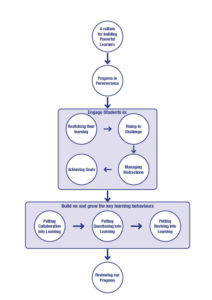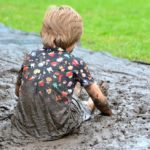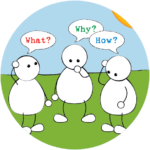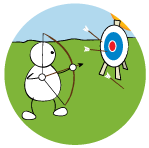Online Programme – Stepping Stones Phase 1
This first phase programme usually takes a school between 12-18 months to complete. All teachers and support staff are given access to the materials. A popular approach is to undertake one module each month. Staff read and consider the material in, say, week 3 of the month and meet together in teams in week 4.
The course covers four key Learning Power Habits: Perseverance, Collaboration, Questioning and Revising.
How the online programme works
The Stepping Stones Phase 1 programme consists of nine online sessions, each expected to take about a month to implement in classrooms. Each online session is divided into four sections:
Three individual teacher sections
Teachers work their way through the materials at a time and place to suit them. Each session will usually take about 30-45 minutes to work through and think about. The materials introduce new thinking and practical ideas for staff to get their heads around prior to their team session.
A Professional Learning Team meeting section
This brings staff together as a learning team at monthly intervals (typically six to eight staff per team), convened and led by a learning champion from your school. Staff share and discuss how they have moved their practice to incorporate learning behaviours, consider new material introduced in the individual online learning sessions, and plan their learning enquiries to be implemented in the next month. Each team session is planned to last about an hour.
The online sessions consist of:

a) A Culture for building Powerful Learners
Best used as the first session, this module is designed to guide you through a process of understanding, assessing and improving your classroom learning culture; making it more learning friendly in order to build your students’ learning power. Unpick the meaning of classroom cultures; use a learning power culture instrument to assess where your classroom culture is now; ready your culture for learning.
Unpick the meaning of classroom cultures; use a learning power culture instrument to assess where your classroom culture is now; ready your culture for learning.
- Learning cultures. A big shift? Unpick the meaning of classroom cultures, what they might consist of and the big shifts that may be needed to develop better learning. Use the culture tool to estimate where your classroom culture is now.
- Learning friendly cultures; Lots of little shifts. Find out about the four big dimensions of culture and use the culture tool 2 to estimate the sorts of shifts your classroom culture would benefit from.
- Your classroom culture. Some ideas to get you started. Look for ideas to strengthen your learner/learning classroom culture.
- Team reflection and planning. Share the results of your culture analysis with colleagues. Make plans for what everyone needs to do and what you will each do individually.
b1) Progress in Perseverance
Perseverance is key to the learning journey. It is vital that pupils are able to get to grips with the knotty emotions of learning, and can view and use them positively as aids to the journey, not as setbacks.
This mini-unit is an information unit, it does not suggest practical ideas for improvement. As such it should be coupled with one of the four perseverance sessions below.
The Unit aims to:
- help teachers to explore the components of the big picture of perseverance, how it’s made up
- analyse where their students currently function in relation to progress in perseverance
- look briefly at their own practice in developing a perseverant friendly culture
The following sessions delve deeper into Perseverance and help improve pupils’ attitudes to learning.
The following four sessions delve deeper into each aspect of perseverance, helping you to develop and grow pupils’ learning-friendly attitudes.
b2) Engage students in unsticking their learning.
This session aims to:
- help teachers to analyse how their students’ behave and feel about being stuck;
- help teachers to look at their own classroom practice in developing a ‘stuck’-friendly culture;
- suggest practical strategies to increase students’ skill and confidence in dealing with being stuck;
- assist teachers to adapt their practice using a learning enquiry method (Team reflection and planning).
b3)Engage students in rising to the Challenge.
This session aims to:
- help teachers to analyse how their students feel and behave when faced with challenge
- help teachers to look at their own classroom practice in developing a learning-challenge-friendly culture
- suggest practical strategies to increase students’ skill and confidence in dealing with challenge• assist teachers to adapt their practice using a learning enquiry method (Team reflection and planning).
b4) Engage students in Managing Distractions.
This session aims to:
- help teachers to analyse their students’ awareness of and strategies for being distracted
- help teachers to look at their own practice in developing a learning culture that helps students to maintain focus
- suggest practical strategies to increase students’ skill and confidence in dealing with internal and external distractions
- assist teachers to adapt their practice using a learning enquiry method (Team reflection and planning).
b5) Engage students in achieving Goals.
This session aims to:

- help teachers to analyse how their students’ think and feel about pursuing goals
- help teachers to look at their own classroom practice in developing a goal friendly culture
- suggest practical strategies to increase students’ skill and confidence in pursuing goals
- assist teachers to adapt their practice using a learning enquiry method (Team reflection and planning).
The following sessions explore how to build on and grow the key learning behaviours:
c) Putting Collaboration into Learning.
 At its least sophisticated, collaboration is little more than being cooperative. At its most sophisticated and complex level it goes beyond learning ‘in a team’ and becomes learning ‘as a team’. It is an invaluable life skill.
At its least sophisticated, collaboration is little more than being cooperative. At its most sophisticated and complex level it goes beyond learning ‘in a team’ and becomes learning ‘as a team’. It is an invaluable life skill.
This session is designed to guide you through a process of building the habit of Collaboration in your pupils. Sections 1 – 4 consider:
- Collaboration and how it develops. Unpick the meaning of Collaboration, how it develops over time and use the Collaboration chart to plot where your pupils are now.
- Taking Collaboration into classroom culture. An introduction to the classroom culture that nurtures Collaboration. Check what you do now.
- Introducing activities and routines that will build Collaboration into learning activities/tasks.
- Team reflection and planning. Share the impact of your experiments with colleagues and plan what you need to do next.
d) Putting Questioning into Learning

The desire to ask questions to satisfy innate curiosity is alive and well in very young children, as any parent of a 3 year old will readily confirm! Explore how we can ensure that questioning remains alive and builds into a full-blown inclination to explore and learn about the world.
This session is designed to guide you through a process of building the habit of Questioning in your pupils.
- Questioning and how it develops. Unpick the meaning of Questioning, how it develops over time and use the Questioning chart to plot where your pupils are now.
- Taking Questioning into classroom culture. An introduction to the classroom that nurtures Questioning. Check what you do now.
- Introducing activities and routinesthat will build Questioning into learning activities/tasks.
- Team reflection and planning. Share the impact of your experiments with colleagues and plan what you need to do next.
e) Putting Revising into Learning
 Pupils need to learn how to deal with change, emotionally and practically. With an inflexible frame of mind they are unlikely to recognise the need to change their ideas or the way they do something. They also need to know what ‘good’ looks like; how to keep an eye on how things are going and evaluate how things went against external standards. This session is designed to guide you through a process of building the habit of Revising in your students.
Pupils need to learn how to deal with change, emotionally and practically. With an inflexible frame of mind they are unlikely to recognise the need to change their ideas or the way they do something. They also need to know what ‘good’ looks like; how to keep an eye on how things are going and evaluate how things went against external standards. This session is designed to guide you through a process of building the habit of Revising in your students.
Sections 1 – 4 consider:
- Revising and how it develops. Unpick the revising chart and plot where your pupils are now
- Taking revising into classroom culture. Think about how to improve your classroom culture to better support revising.
- Teaching for learning; activities and talk. Look for ways of building revising into learning activities/tasks and the learning language.
- Team reflection and planning. Share the impact of your experiments with colleagues and plan what you need to do next.
The final session in Phase 1 is designed to enable you to review your progress so far.
f) Reviewing our progress
 A rich variety of tools help you review your progress in developing a learning culture in your classrooms. This review will provide you with relevant information on which to base your approach in the next phase of building pupils’ learning powers. Sections 1 – 4 consider:
A rich variety of tools help you review your progress in developing a learning culture in your classrooms. This review will provide you with relevant information on which to base your approach in the next phase of building pupils’ learning powers. Sections 1 – 4 consider:
- Reflecting on your changing practice. Looking at what you have done and how your classroom has changed. This section answers the question “How far have you come?”
- Giving pupils a voice. Finding out how your pupils have benefitted. This section answers the question “How well have the pupils taken to this way of learning?”
- Learning with and from colleagues. Learning from learning walks and observations. This section answers the question “What are the variations on the theme and what can I learn from these variations?”
- Team session: Learning together. Putting your heads together and thinking “what next?” This team session answers the questions “How are we doing, how are our pupils doing and where do we need to go next?”
Take a look at some of the online module..Engage students in unsticking their learning
Preview the online course

Comments are closed.